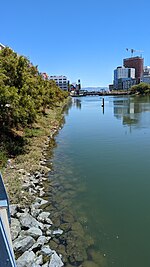UCSF Helen Diller Family Comprehensive Cancer Center
UCSF Helen Diller Family Comprehensive Cancer Center is an NCI-designated Cancer Center, affiliated with the UCSF School of Medicine and the UCSF Medical Center. It is one of 69 cancer research institutions in the United States supported by the National Cancer Institute, and one of three in Northern California. The HDFCCC integrates basic and clinical science, patient care, and population science to address prevention and early detection of cancer as well as the quality of life following diagnosis and treatment. HDFCCC is a member of the University of California Cancer Consortium, the National Comprehensive Cancer Network (NCCN) and Association of American Cancer Institutes. Cancer programs at UCSF have been continuously accredited since 1933 by the Commission on Cancer of the American College of Surgeons.
Excerpt from the Wikipedia article UCSF Helen Diller Family Comprehensive Cancer Center (License: CC BY-SA 3.0, Authors).UCSF Helen Diller Family Comprehensive Cancer Center
4th Street, San Francisco
Geographical coordinates (GPS) Address Website Nearby Places Show on map
Geographical coordinates (GPS)
| Latitude | Longitude |
|---|---|
| N 37.766436 ° | E -122.390389 ° |
Address
UCSF Medical Center at Mission Bay
4th Street 1975
94158 San Francisco
California, United States
Open on Google Maps






